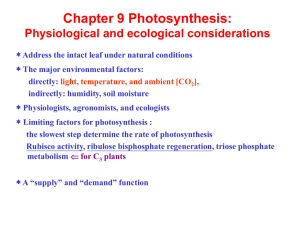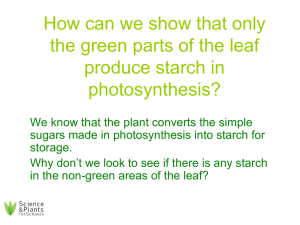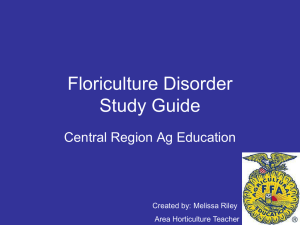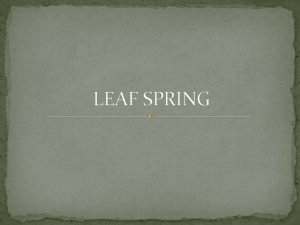Plant Water Stress
advertisement
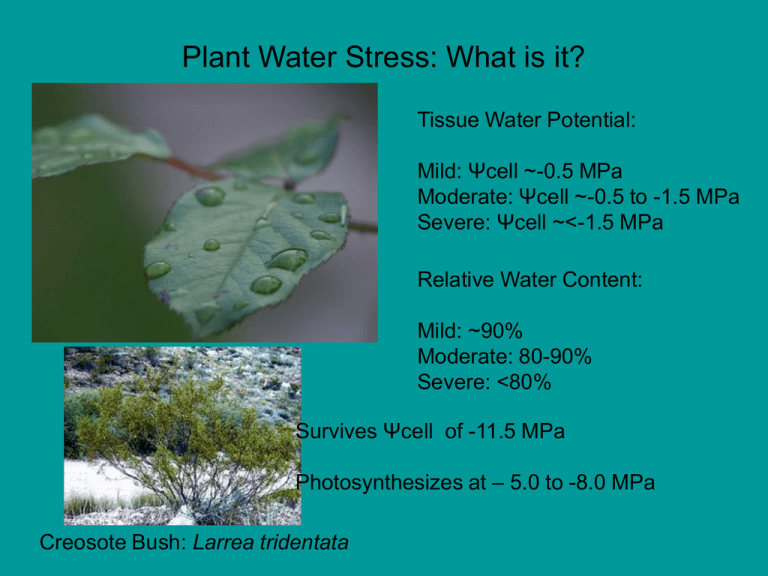
Plant Water Stress: What is it? Tissue Water Potential: Mild: Ψcell ~-0.5 MPa Moderate: Ψcell ~-0.5 to -1.5 MPa Severe: Ψcell ~<-1.5 MPa Relative Water Content: Mild: ~90% Moderate: 80-90% Severe: <80% Survives Ψcell of -11.5 MPa Photosynthesizes at – 5.0 to -8.0 MPa Creosote Bush: Larrea tridentata What does water stress do to plant cells and plants? 1. Loss of turgor Plasmolyzed vacuole Ψp = 0 What does water stress do to plant cells and plants? 2. Reduction in Leaf Expansion Smaller leaves Less extensive canopies Less light reception Less photosynthesis Internal turgor ‘powers’ cell expansion Stressed orange trees What does water stress do to plant cells and plants? 3. Impact on Metabolism •Photosynthesis ↓ Why? •Respiration ↑ Why? •Solutes ↑ Impact? •Change in plant hormone balance: ABA (abscisic acid) ↑ Impact? White Oak stomates (glue impression) Adaptations to Avoid Water Stress Problems of water shortage and maintenance of turgor are universal among terrestrial plants. Why? Strategies: Avoidance and Tolerance California desert after a rain Avoidance mechanisms: root systems Root/Shoot ratio: Temperate forest: ~0.25 Dry Savanna woodland ~0.3 – 0.4 Prairie & deserts ~0.6-0.9 Root growth is plastic and responds to Local conditions (water, soil, etc.) mycorrhizal fungi extend root systems Avoidance mechanisms: leaf modification Leaf pubescence In oaks Blade of grasses “leads” water to base Water tanks in epiphytic bromeliads Leaf rolling in water stressed corn Leaf orientation in Eucalypts Avoidance mechanisms: leaf modifications SLA (specific leaf area) Leaf area / dry weight Deserts (xeric): 0.02 - 0.12 Dry forests: 0.36 - 0.70 Mesic forests: 1.4 -1.6 Lower number means smaller, thicker more dissected leaves Dissected leaves in Palo Verde Avoidance mechanisms: osmoregulation Lower leaf water potential by synthesizing solutes (amino acids, sugars, ions, etc.) What will this do? Leaf anthocyanins in young leaves of Corymbia gummifera Avoidance mechanisms: stomatal regulation Hydroactive closure – first line of defense Regulated by ABA Hydropassive closure – second line of defense Regulated by general loss of turgor Subsidiary cells Subsidiary cells Avoidance Mechanisms: C4 and CAM Plants CAM plant - pineapple C4 grass - sugarcane Tolerance mechanisms Creosote Bush Craterostigma plantagineum Polypodium polypodioides Selaginella lepidophylla How do plants that tolerate extreme water stress survive? • What adaptations would these plants have to conserve water? • In what type of habitats would these plants be found? • How do these plants prevent damage to their cells during dehydration-rehydration cycles? • How long does it take for a resurrection plant to revive after drying? Is the length of this time important for survival of the plant? • What kind of growth rates would these plants show?




